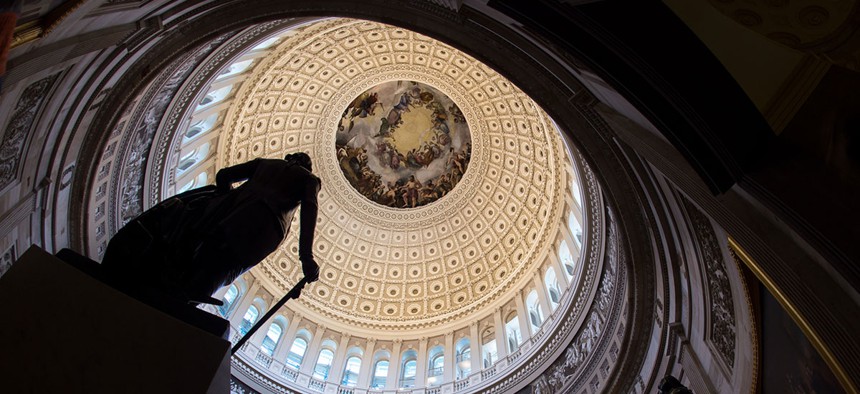There’s a Slim Chance the Senate Will Vote to End the Shutdown
Lawmakers are voting on dueling proposals to reopen the government on Thursday, and key Republicans won’t say where they stand on the Democratic offer.
Federal employees on the verge of missing their second consecutive paycheck should not get their hopes up about the pair of dueling votes to reopen the government that will take place in the Senate on Thursday.
Both proposals—one representing President Donald Trump’s proposed trade of $5.7 billion in border-wall funding for temporary protections for some undocumented immigrants, and another that would simply end the shutdown—are expected to fall short on the floor.
But the failure of one is more certain than the failure of the other: While Republican senators have rallied behind the president’s plan, they have not ruled out also voting for the rival proposal, a measure, backed by Democrats, that would reopen shuttered federal agencies for two weeks while the parties negotiate a broader agreement on border security. And thanks to House Speaker Nancy Pelosi’s refusal to allow Trump to deliver his State of the Union address next week if the government is closed, Republicans might have an added incentive to seek at least a temporary break in the impasse.
After the president wrote to Pelosi on Wednesday insisting that the annual speech go forward “on location” in the House chamber, the speaker swiftly replied that the House would not pass the required resolution allowing that to happen. By late afternoon, a frustrated Trump conceded Pelosi had “canceled” his Capitol address, and suggested he would look at an “alternative” location to hold it. “I don’t believe it’s ever happened before, and it’s always good to be part of history, but this is a very negative part of history,” the president lamented. Late Wednesday night, however, Trump relented. “This is her prerogative,” he said in a tweet, referring to Pelosi. “I will do the Address when the Shutdown is over.”
If Pelosi’s requirement is that the government be open for the State of the Union to proceed as planned, the Senate on Thursday will have its opportunity to make that happen. The votes will be the chamber’s first attempt to end the record-long shutdown.
Both measures would require a filibuster-proof 60 votes to advance, meaning that either seven Democrats would have to back Trump’s plan or 13 Republicans would have to support the alternative. Most Democrats have roundly condemned the president’s proposal, which contains what they consider “poison pill” provisions that would make it harder for refugees to seek and obtain asylum in the future. The Democratic measure, which has already passed the House, is more straightforward—a clean but short-term, continuing resolution with a sweetener of billions of dollars in disaster-relief money—and Republicans have been quieter in their opposition.
On Wednesday, I surveyed the offices of 23 Republican senators who frequently or occasionally cross party lines to see how they planned to vote. Of those that responded—about one-third—all indicated that they planned to back Trump’s proposal, but none definitively came out against the Democratic alternative. A spokeswoman for Senator Lisa Murkowski, for example, said the Alaska Republican supports the White House plan, but added, “She is planning to support anything that allows for a process for us to reopen the government as soon as possible, while addressing border security.” Representatives for Senators Johnny Isakson of Georgia and Mike Enzi of Wyoming said they were each studying the Democratic proposal.
That sampling is not an indication of momentum—none explicitly endorsed the second plan either. But it suggests that Republicans are keeping their options open, raising the possibility that once the Trump plan fails, they could vote with Democrats to temporarily end the shutdown. Republican senators have harbored thinly veiled frustration with the president for the past month, ever since his abrupt decision to oppose a spending bill they voted out of the chamber, precipitating the shutdown’s start. They welcomed Trump’s recent bid to jump-start negotiations by offering limited protections for recipients of the Obama-era Deferred Action for Childhood Arrivals program, which at least gave Republicans an offer to rally around.
Yet for the president and for his party, the political pressure to end the shutdown is only increasing. Furloughed federal employees protested inside a Senate office building and outside the locked Kentucky offices of Senate Majority Leader Mitch McConnell. The rate of absences for unpaid Transportation Security Administration agents has been increasing, and TheWashington Post reported that hundreds of IRS employees were skipping work because of financial hardship, jeopardizing the completion of on-time tax returns. Federal courts will soon run out of money, and FBI investigations are grinding to a halt.
Polls continue to show that a majority of Americans blame Trump for the shutdown, and a survey released Wednesday by the Associated Press foundthat the president’s approval rating dropped sharply over the past month, to 34 percent, its lowest level in more than a year. “What more do my Republican colleagues need to hear? The will of the American people is crystal clear: Open the government,” said Senator Chuck Schumer, the Democratic leader, in a plea to the GOP on Wednesday.
Chances are that the mounting personal toll of the shutdown and the apparent verdict of the public will not be enough to get the government open on Thursday. But the number of Republicans who vote with Democrats will be a measure of the party’s resolve as the impasse moves into its second month, as well as the first sign of how close it is ending.
NEXT STORY: Are You Triaging or Prioritizing Your Work?



